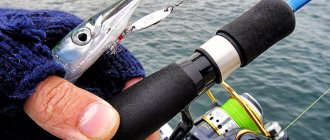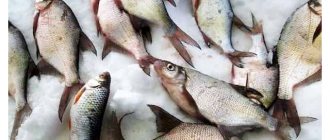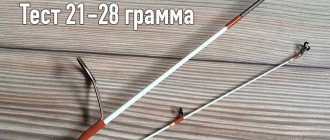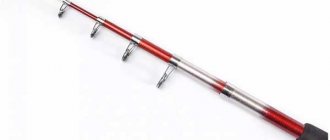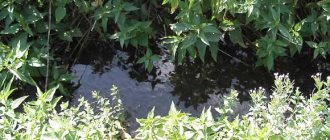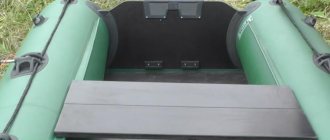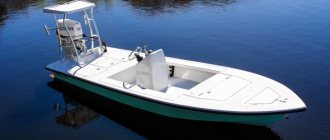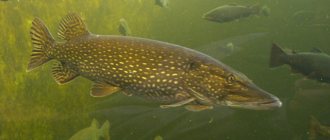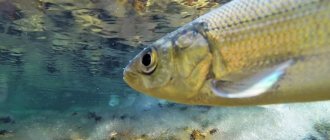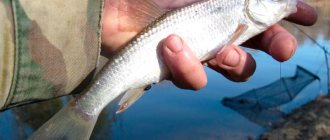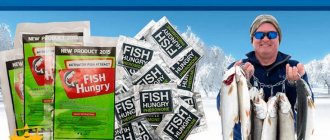At what pressure does fish bite better in winter?
For many fishermen, fishing is an activity that brings relaxation and relaxation. Nevertheless, everyone wants to return home with a catch. Sometimes, upon arrival for fishing in winter, fishermen are provided with a “mad” bite, during which the activity of underwater inhabitants goes off scale. And there are days when the fish bites rather sluggishly, shaky, or even refuses the bait. As practice shows, water pressure parameters have a special influence on the quality and activity of the bite.
There are two main theories that explain the effect of atmospheric pressure on fish behavior:
- According to the first, during the change from a cyclone to an anticyclone and vice versa, the volume of air in the swim bladder of fish changes, as a result of which it becomes much more difficult for them to move in the water. That is why, after sudden surges in pressure, aquatic inhabitants can reduce activity and react poorly to bait.
- The second theory excludes the direct influence of changes in pressure , but suggests that such phenomena coincide with other weather changes, in particular cold or thaw, which affect the behavior of fish.
Regardless of which theory is correct, the fact that in winter the activity of aquatic inhabitants is associated with pressure remains a fact.
Important! A slow, gradual decrease or increase in pressure has virtually no effect on the activity of fish. If the position of the barometer needle changes sharply up or down, it is better to give up fishing, as the bite will be very sluggish or there will be no bite at all.
Of course, when going winter fishing, every fisherman should know at what pressure the fish bite better:
- High . As a rule, in winter, with high pressure, clear, sunny and frosty weather prevails. Temperatures drop during this period, and after the barometer needle rises to the top, frost sets in. The time of sustained high pressure is great for fishing. Both peaceful inhabitants of reservoirs and predators are highly active.
- Low . In winter, when the barometer needle drops to the lower position, the weather changes to cloudy, more humid, and temperatures rise. A period of persistent low pressure that can last for several days is almost ideal for fishing. These days, the fish become more active, begin to intensively search for food and respond well to bait.
Ice fishing
Pre-winter migrations of freshwater fish in the reservoirs of our country begin long before the appearance of snow cover and the establishment of ice. In autumn, due to a decrease in water temperature, the underwater environment changes significantly. A decrease in water temperature, as well as the length of daylight hours, in addition to the impact on the fish’s body, also affects the development of aquatic plants and other aquatic organisms that are natural food for fish.
The life activity of fish also depends on the amount of oxygen dissolved in water. Sources of saturation of water with oxygen are atmospheric air and partly aquatic vegetation, and in the daytime algae act as producers of oxygen, and in the dark as its consumers.
A decrease in daylight hours already in the autumn months gradually worsens the conditions for fish to stay in shallow places, in faded and browning grasses. There are no insects in the cool air, so fish have nothing to do in the upper layers of the reservoir now.
By mid-autumn, the fry had matured, grown stronger and, together with older fish, migrated to the river beds, to the depths. Following them, predatory fish went into the depths.
Experienced fishermen are well aware of how gradually, as the water cools, the places where bream stay and feed change. Breaches determine these places based on phenological characteristics. If in large reservoirs in June - July bream are caught near lush and juicy greenery at a depth of 2-4 m, then in August - September this fish can be found at a depth of 5-7 m, and later - at even greater depths.
Where freeze-up occurs regularly, the manifestation of the main links in the annual cycle of fish is usually associated with the opening of the reservoir and freeze-up. These factors are turning points in the life of nature and have a significant impact on the life of fish.
Not only in winter, but also in the cold autumn months, many fish living in inland waters behave passively. Like other animals with an unstable body temperature, fish are highly dependent on environmental temperature, which greatly affects the metabolic rate of the fish and its diet.
Each type of fish has certain temperature limits within which they begin and stop feeding. The optimal temperature for the most intensive fattening of different fish species is also different. For example, carp begins to feed only at 8-10°; it feeds most intensively, and therefore is caught, at 18-26°. When the temperature drops below the lower limit, the metabolism of some fish slows down so much that they stop feeding altogether. Catfish, tench, carp, and carp fall into a state of torpor. An unpretentious crucian carp burrows into liquid silt. Here it finds a reliable shelter even in cases where the water freezes to the bottom. This phenomenon, called suspended animation, is observed everywhere in reservoirs with long periods of freeze-up.
Freeze-up significantly reduces the access of oxygen to the water column. Snow falls on the ice, and less and less light penetrates into the water. Dead grasses and other organic debris that sink to the bottom decompose, absorbing dissolved oxygen from the water and releasing harmful gases. Plants that turn green even in winter - stems of elodea, small bushes of teloresis, “self-seedlings” of pondweed - emit less oxygen. In many reservoirs, some time after freeze-up, fish begin to experience oxygen starvation and eat less.
Still, winter fishing is exciting, especially at the beginning of winter and before the ice breaks up. Not all bodies of water freeze at the same time. Wind-protected ponds, quarries, shallow lakes, quiet bays and reaches freeze before others. In low-water ponds and quarries rich in vegetation, death often occurs. Winter fishing here continues for a month, or even just a few days after freeze-up.
Fishermen are in a hurry to catch fish in early freezing reservoirs: after all, now they can fish among old snags, flooded bushes and in other places that are not easily accessible during open water periods. All fish that do not hibernate are successfully caught on the first ice. Restless perches chase fry and juvenile fish in flat, shallow places, as well as on the approaches to dark snags, where larger specimens live alone or in small schools.
For the last time of the year, pike perch increase their aggression. From the cluttered places of their permanent home, they with particular zeal make attacks on narrow white fish and reddish ruffs. Pike prowl throughout the pond. On deep reaches and holes, slightly silty or with a stepped clay bottom, bream, bluegill, and silver bream are caught. Successful catches of this fish also occur in deep places with a sandy or pebble bottom.
Roach fatten on medium-depth reaches with a slow current, and in lakes and reservoirs - near thickets of reeds and reeds.
Below the riffles and shallows, dace and minnows are excellently caught. The ruff bites almost everywhere.
Asp, chub, and ide behave more passively. Asps and chubs no longer roam the rapids and rifts. In the quiet depths of holes with rocky or other durable soil, they sometimes get hooked when catching other fish. In new roach sites, roaches and small chubs are often fished out. In the first days of freeze-up, large ide, burbot and pike can be found in very shallow places where they stand very close to the surface. Adult ides are occasionally caught off the coast with steep slopes, at the mouths of tributary rivers, and in lakes - at shallow depths near vegetation that has sunk to the bottom. In the first ice season, the pre-spawning feast of burbot begins. This bottom predator feels better and becomes more mobile in cold water.
Each body of water has its own winter life and its own characteristics. They manifest themselves in different ways. Much depends on the water level and sources of its replenishment, the timing and nature of freeze-up, ice thickness, snow cover and other reasons. All these factors influence the placement and life of fish under the ice.
To collect information about fishing spots in unfamiliar bodies of water, you can use the advice of local fishermen.
In winter, the fish conserves its strength and avoids fast currents. Habitual wintering pits and other places favorable for calm water, availability of food and oxygen conditions will now become permanent housing for her until the onset of pre-spring revival. Observations confirm that temporary changes in the sites chosen by fish occur during significant rises or falls in water, during prolonged thaws, as well as in cases where fish are disturbed by net fishing or the massive presence of ice fishermen.
A major event in the life of river inhabitants is the temporary, but at the same time massive movement of fish caused by the appearance of slush. At the first frost, flood lakes, bays, and backwaters freeze, and the rivers still have unreliable banks, blackened water like cast iron flows. The ice does not form immediately: the silkworm areas protected from the wind become captive, and lard and broken ice flow over the deeper reaches. The first frosts are usually replaced by warming, accompanied by lines, heavy rains, and watery snow. The water begins to rise, rise, and breaks the barriers with a crash.
Disturbed fish, as during the spring ice drift, cling to the quiet shores, singly and in flocks enter tributary rivers, creeks, backwaters and flood lakes connected to the river. Fans of winter fishing rush to these reservoirs.
Only in a week or two will real frost break out, the rivers will freeze, and with the greatest caution it will be possible to cross from bank to bank.
On first ice, in favorable weather, fish can be caught from early morning until late evening. At the end of the first month after freeze-up, the fish's quality of life gradually worsens. In some reservoirs it stops altogether, in others it becomes uneven. The “dead” time is coming. In the middle of winter, especially in February, fish cleavage is so uneven. that it can be considered random. The unevenness of the left is explained by weather conditions. Weakened by winter existence, the fish is more sensitive to sudden changes in weather.
The question of the influence of weather conditions on the behavior of fish has not been studied enough. Ice cover is not a barrier to atmospheric pressure. With a sharp drop in pressure, the fish reduces its feeding or stops taking food altogether. Other atmospheric changes also affect the behavior of fish.
Fluctuations in air temperature, it would seem, should not affect the fish - after all, the temperature of the upper layer of water near the ice is always the same - close to zero, and in the bottom layers it reaches approximately + 4 ° C and is also constant. However, in severe frosts the fish hardly feed. How can a fish sense under the ice where the wind is coming from? And she feels it. This is confirmed by the observations of many fishing enthusiasts. Significantly strong winds from an unfavorable direction in the vast majority of cases worsen the bite.
What kind of fish bites in winter?
Winter fishing is considered very productive, especially during the first ice period, when the majority of underwater inhabitants respond quite actively to bait. At this time you can hunt for pike, perch, pike perch, roach, and bream. When winter firmly comes into its own and the period of deep winter begins, the activity of fish decreases, their behavior becomes more passive. At this time, fishermen do not expect to catch crucian carp, catfish or tench, but can hope for a bite from perch, ide, pike perch, pike, and cod species, such as burbot.
At the end of the winter period, when the weather signals the imminent arrival of spring, the behavior of the fish becomes more active. In the second half of February, almost all types of underwater inhabitants are highly dynamic, but especially ruffs and thorns. Also, perch, roach, pike, pike perch, silver bream, and carp will be caught on the fisherman’s hook.
Species diversity of fish in a winter river
Fishing in winter on the current carries a certain element of surprise. Unlike lake fishing, the river can pleasantly please you with both decent small items and trophy fish.
- Of the peaceful representatives of the ichthyofauna, several species should be noted. In winter you can count on catching trophy bream or chub. But most often the catch includes bream, silver bream and roach.
- The rivers are home to many species of predatory fish. The largest representatives are pike and pike perch. Some fishermen purposefully hunt for perch, burbot or nosebleed ruff.
Photo 1. The kings of the river are ruffs!
Depending on the type of fish selected, suitable equipment is supplied.
What do they use to catch in winter?
To successfully fish in the winter, you need to know what baits the fish respond well to.
Experienced fishermen most often use the following as winter “bait” products:
- Bloodworm is the larva of a mosquito. Such bait works great in almost all bodies of water when catching any type of fish, except for predators - pike perch, pike, catfish.
- Worms are the most optimal bait option, which is used in the absence of others.
- Maggots are the main competitors of bloodworms in winter fishing. Quite often they are used in a paired combination in the form of a “sandwich”: bloodworm - maggot. Perch, ide, ruffs, and all peaceful fish bite remarkably well on this type of bait.
- Mormysh is a reliable and high-quality bait, which is an amphipod crustacean. All peaceful representatives of the river world love mormysh, as well as some predators - pike perch and pike.
- Burdock moths are yellowish-white larvae that are located in the seals of burdock cones. They work great during the dry winter, when the bite weakens. They work great in combination with bloodworms.
In addition to live bait, artificial baits are used during winter fishing:
- Spinner . Used to “hunt” large fish and predators. The design of the baits makes it possible to play with the spinner when rising and falling, thereby attracting aquatic inhabitants.
- Front sight . Its main function is to imitate the movement of insects, worms or larvae.
Other types of baits are also used: jigs, “devils”, “eggs”, balancers.
Find out more about how to catch carp with boilies.
Wrong equipment for winter fishing
Shoes intended for everyday wear, even if they are made with natural fur, will not save you on ice. A windswept short jacket is also not an option for an ice fisherman. And if you put on a thin knitted cap, then after 20 minutes of being on the pond you will feel that the wind, which you did not feel at all in the city, has raged with terrible force.
During winter fishing, you are in motion only when drilling holes or moving between fishing points. The rest of the time, sit.
If you are not dressed correctly, then during active activities it will be hot and you will sweat. And as soon as you sit down near the hole, your body will begin to cool down, the released moisture will freeze on those layers of clothing that it has managed to absorb. In general, if you are lucky and the frost is not severe, you can hold out for a couple of hours, but then it will get worse.
If you don’t have the financial ability to purchase a modern set of clothes, which consists of thermal underwear, overalls, jackets, special shoes, gloves and a hat, it doesn’t matter. First, look for felt boots or burkas with galoshes.
Shoes should never be too small! Ask neighbors, friends and acquaintances. Ask them if they happen to have a sheepskin coat or a fur coat made of natural fur. Long jackets with padding polyester or down, cotton pants, and a fur hat with earflaps are suitable.
Be sure to wear several layers of clothing. Underwear made of cotton materials, fleece fleece or wool sweater (you can have more than one). Personally, I use and recommend everyone to wear various vests. I have fleece and down vests (almost like a sleeveless jacket). This item of clothing warms the body, but leaves your hands free - this makes it much more convenient to work with winter gear.
What equipment do you need for winter fishing?
The equipment of a winter fisherman has some specifics and differs from what is needed in the summer. First of all, it should not have unnecessary items. It is necessary that clothes and shoes be as warm as possible, but at the same time light, free and not hinder movements. In addition, you should stock up on essential accessories.
Ice pick and ice screw
One of the most necessary accessories for winter fishing is an ice pick - a tool used to make holes and also check the reliability of the ice in front of you while moving along a frozen river.
In some cases, breaking through ice with an ice pick is quite difficult and time-consuming, so an ice drill is used instead. Such a device copes well with the task of drilling holes; it has a compact size and is convenient for transportation. Today, manufacturers offer ice drills that operate on gasoline or electrically driven units. Although they allow you to make a hole in the ice quickly and without much effort, they are characterized by large dimensions, weight and high cost.
Important! Experienced fishermen consider a manual auger ice screw to be the best option.
Skimmer
A slotted spoon or scoop is a device in the form of a large spoon with holes, which is required to clear the surface of the water from snow or a thin layer of ice. During winter fishing, you have to clean the water surface quite often, so it is advisable to always take a slotted spoon with you.
Mothworm
If you plan to use bloodworms as bait, then you need to take care to take with you a special foam device - a bloodworm, which protects the larvae from freezing. When planting bait, you need to quickly remove the bloodworm from such a box, and then just as quickly remove it. This procedure should be done every time.
Thermos and food
Herbal tea or coffee, which is recommended to be taken in a thermos, will help you avoid freezing during a long stay in the cold. The body spends a lot of energy and effort on warming itself, so a cup of hot drink will be an excellent warming agent during long walks. In addition, experts advise stocking up on food. A sandwich with lard and black bread will be especially useful in winter.
Experts do not recommend taking alcohol-containing drinks such as moonshine or vodka when fishing. They have a relaxing effect, reduce reaction, as a result of which the fisherman can fall asleep and freeze.
Find out more about which hook to choose for catching carp.
Feeder
Many options for fishing involve the use of a feeder - a special cone-shaped box made of plastic or metal, which has holes and a lid that folds back during the jerk. The device is tied to the fishing line of a fishing rod with a reel in order to later lower it to the center of the bite and open it at the bottom, releasing complementary food.
Fishing with a feeder from ice
The concept of an under-ice feeder appeared in the everyday life of bottom fishermen not so long ago, after they tried to use an ice feeder to catch white fish in holes. In such a situation, the advantages of a feeder form when casting equipment are irrelevant, so they use a “mini” feeder equipped with a small spinning reel.
When fishing with standard winter fishing rods at a considerable depth, inconvenience arises when landing the fish, especially if after the bite it has already reeled off a few more meters of line. Delicate fishing with a mini feeder reel brings a lot of pleasure to the angler, and allows you to catch even large carp or silver carp.
Most often, when fishing on an ice feeder, the main target is bream or crucian carp, but catching carp is quite possible, and it is better to catch such fish with reliable tackle. In such cases, all the advantages of the feeder are fully demonstrated, and the angler copes with fish of any size.
Making an under-ice feeder with your own hands is not that difficult, and its main element is the quivertip, which is sensitive to bites from fish of any size.
But the range of fishing products from well-known manufacturers now includes winter feeders for ice fishing, which show excellent results. As an example, let's take Ice Feeder from Salmo. The advantages of an ice feeder appear when fishing in a reservoir with an uneven current and great depth, in conditions where it is impossible to use standard winter feeders. Fishermen have noticed that in winter they catch larger fish on the feeder than on jig tackle; apparently, they prefer low-active baits.
Line selection
For fishing with an ice feeder, use a fishing line with a diameter of 0.14–0.16 mm and fluorocarbon leaders with a diameter of 0.10–0.12 mm. You should not get carried away with fishing lines that are too thin; they do not provide any advantages, but can break at the most inopportune moment. The base must be of high quality, as well as the leading line, so you shouldn’t skimp, especially since you won’t need a lot of line for winter fishing.
The length of the leashes depends on:
- current forces;
- fish activity;
- nozzle size;
- weight.
Hooks for ice feeder
The hooks on the under-ice feeder rig should be inconspicuous and very sharp, instantly detecting the fish. The weaker the current in the reservoir, the less the weight of the hook used should be, but the use of jigs is unjustified. The most popular hooks are numbers 14–18 from the Ovner company.
Feeders
When fishing from ice with a feeder, small feeders weighing 10-40 grams are used. The minimum feeding capacity prevents the fish from becoming saturated with bait, and it will definitely become interested in the bait on the hook. Plastic feeders are more convenient and float up faster from the water column, and closed-type feeders are better; it is more convenient to put bait in them in the cold and it is easier to regulate the rate of its leaching.
Lure
For an under-ice feeder, it is better to use purchased mixtures from Sensas or other trusted manufacturers. There is no point in messing around with homemade bait, because you won’t need much of the mixture, and in winter, as we remember, it is easier to overfeed the fish. The bait needs to be well moistened so that it does not “dust” when the feeder is immersed in the bottom of the reservoir. When fishing at great depths, soil is added to the bait to make the feeder heavier and speed up its descent in the water column.
Tactics and fishing techniques
When fishing in a familiar body of water, fish resting places, deep holes and undercuts are selected, where holes are drilled. If the reservoir is poorly studied, a hole is drilled in an arbitrary place in order to determine the strength and direction of the current and choose the right feeder. In such conditions, exploratory fishing is more logical, so you will have to drill a lot of holes until the most promising point is found.
Preliminary feeding is no more than three feeders, and fishing is carried out with two rods located at a distance of 2-3 meters from each other. The rod located upstream is equipped with a feeder and a leash. The feeder that is located below is equipped not with a feeder, but with a sinker, so as not to overfeed the fish.
The current carries the bait from the upper feeder to the lower one, and it successfully attracts fish. In practice, it turns out that bites on the feeder with a feeder begin earlier, but after half an hour - an hour, the lower rod begins to register bites from fish approaching the feed. As a result, the angler has bites on both feeders, and even if the fish is minimally active, he will not have to freeze.
Important!!! You should not add animal components to the bait and place several bloodworm larvae on the hook. This way you will not overfeed the fish and force it to react to the proposed bait, which it can quickly swallow.
Winter fishing options
There are a huge number of options for winter fishing, differing in the degree of difficulty, types of gear used, and tactics. However, experts advise beginners to start with the simplest methods, for example, the use of clover, zherlitsa, tyrant, etc.
Sheer lure
Spinning is considered the most active type of winter fishing. However, this type of fishing is not suitable for novice anglers, since “playing” a spinner requires certain experience and skills. Experts advise beginners to take up jig fishing.
Did you know? The largest fish caught on a traditional fishing rod was a man-eating white shark. The length of the predator was a little more than 5 m, and its weight was 1.2 tons.
Sheer lure allows you to “hunt” perch, pike perch, pike, and burbot. In this case, the fisherman will need the following gear: a fairly strong fishing rod with a reel, fishing line, leash, special lures. It is advisable to use balancers and vertical spinners as bait and bait.
In order to attract prey, you need to regularly twitch the fishing rod, performing certain techniques of playing with a spoon, for example:
- lower the spoon to the bottom;
- raise it by 10–15 cm;
- make several smooth rises of 10–15 cm, observing small intervals between movements;
- Lower the spoon completely to the bottom and wait a while.
Sheer trolling requires skill, so experts advise gaining experience from more professional fishermen.
Fishing with a float rod
Quite often in winter, fishermen practice fishing with a float rod. Fishing with this gear is effective and efficient; it allows you to catch perch, silver bream, roach, bream and carp. Worms, bloodworms and maggots are suitable as bait.
Secrets of fishing on a feeder in winter
When fishing on a feeder in winter, large specimens usually bite from the bottom and therefore you need to ensure that the bait is always in close proximity to it.
When using long leashes that slowly sink into the water column, bites from small fish are possible even before the hook with the nozzle sinks to the bottom. To enlarge the catch, shorten the length of the leash, or attach a shot 4-5 cm from the hook, which acts as an additional weight. Pay attention to whether the fish is hooked on the lower lip, because if this is not the case, you need to either shorten the leash (when possible) or install a float shot.
An active bait often scares away large fish in winter and, conversely, attracts small fish. Winter trophies are extremely picky about baits, so keep the bait bloodworms in perfect condition, as well as maggots, if used. The bait on the hook should behave naturally, move and attract fish with its movements.
Additionally, the flavor combinations of the nozzle vary and attractive sprays are used for this. These are liquids with unique aromatic characteristics, containing amino acids and tinted in bright colors, with which the nozzle is sprinkled. Large fish are attracted by the original aroma and provoked to bite.
Winter feeder fishing conditions tend to vary from region to region, but in most cases the use of sprays brings real results and increases the size of the catch. By experimenting with scents, anglers select the ones that work best and thus improve their fishing results. It is not necessary to have a huge selection of flavors, but it is advisable to keep a few popular flavors in a feeder box. Among them:
- anise;
- bloodworm;
- garlic;
- fish combinations;
- hot spices.
Over time, each angler acquires a set of favorite and working flavors that show the best results in his region.
Video: Bottom fishing
Sometimes a slight movement of the bait is enough for the fish to start biting. In some cases, the bite starts as soon as the donkey is placed on the stand.
Fishing with a fishing rod
To catch perch in winter, use a reversible fishing rod, which includes: a fishing rod, a red foam handle and knitting needles threaded through the handle. To attract fish, fry, small fish pieces, and worms are used.
Did you know? The largest freshwater fish caught was sturgeon, whose weight was 212.3 kg. Sturgeon fishing began in the US state of California in 1983.
Fishing by reversing is easy:
- a fishing line with a hook, sinker, bait and float is lowered into the recess;
- the handle is placed near the hole;
- waiting for a bite. As soon as the perch begins to bite, the rod is pulled into the hole, but hangs on the needle with the handle up.
The advantage of this type of fishing is that you can use up to 5-6 gear at the same time, arranging them in a checkerboard pattern.
Fishing with a girder
A zherlitsa is a simple design, but very effective device for catching fish, which consists of a stand, a reel, a signal device with a flag, a fishing line, an eyeliner and a hook. Unlike spinners, the use of which is justified in certain conditions, the use of a spinner is more universal in nature and makes it possible to fish in any, even unfamiliar, bodies of water.
It is advisable to use such gear for “hunting” pike and pike perch. Live bait is used as bait - roach, bleak, crucian carp, gudgeon, rudd.
Also check out the features of an electronic fishing rod for ice fishing.
The technology for fishing with a girder is simple, but it requires compliance with some rules:
- the gear is installed just before sunrise, since the pike does not feed at night;
- the vents are placed along the edge line in a chaotic manner or according to a special pattern;
- the depth of immersion of the girders is regulated: if the gear is located in the river bed - then 1 m from the bottom, in other cases - 0.5 m;
- After installing the rod, the hole is sprinkled with snow or covered with material so that it does not become covered with ice.
Care must be taken to ensure that the coil has no play and that the alarm has a sensitivity of 0.1–0.15 kg. In order for fishing through girders to be as effective as possible, experts advise periodically rearranging fishing rods and punching new holes. If there is no bite within 2 hours, you must move to a new place.
Fishing for a tyrant
The tackle, under the original name “tyrant”, is a system consisting of a main fishing line and a replaceable undergrowth to which spinners and hooks with artificial bait are attached. The winter version of the tyrant is a reel handle made of dense foam, equipped with a rigid small rod, 20–30 cm long. The sinker is tied at the very bottom, and the greater the depth of the reservoir, the heavier the load should be. The fishing line is used no more than 180 cm, otherwise it will be inconvenient to pull it out. The interval between hooks is 10–15 cm.
We recommend that you find out what beginners need for winter fishing.
The main tactics of fishing with a tyrant is to twitch the tackle, carry out swinging movements - lowering to the bottom and lifting up. Such a device is well suited for catching smelt, navaga, and herring.
Montages used
When fishing with a feeder in winter, it is necessary to use self-tapping rigs and, in particular, an asymmetrical loop, the design of which ensures that the fish is caught even if the angler misses the bite. The equipment is removable and its design features are as follows:
- length of twist with loop for leash – 15 cm;
- loop length 10–11 cm;
- hanging in the loop up to 7 mm.
Unlike the classic asymmetrical installation, where the loop reaches 20 cm, in the winter rig the loop is shorter, which ensures high sensitivity of the rig and the fisherman can clearly see that the fish has taken the bait and needs to hook it. But the bites in winter are accurate, so the participation of an angler who catches the fish is mandatory.
The equipment is tied on a fluorocarbon fishing line with a thickness of 0.16–0.18 mm, which maintains the necessary rigidity and provides camouflage of installation.
Ice fishing safety measures
Winter fishing is a fascinating, interesting, but quite dangerous activity, which in some cases is associated with a risk to life.
To protect yourself, experts advise taking some precautions:
- never go out on thin ice;
- move around the reservoir exclusively with an ice pick;
- if there are doubts about the reliability of the ice, then you need to move very carefully, placing the backpack with the equipment on one shoulder. In case of an unforeseen situation, this position will allow you to quickly free your hands and remove excess weight;
- If the ice cracks, it is strictly forbidden to run on it. You need to lie down on the surface and crawl towards the shore;
- It should be remembered that transparent ice of a dark color is stronger than cloudy ice, however, areas with an almost black ice coating are considered very dangerous;
- if there is a large accumulation of snow on a reservoir, you need to be extremely careful, move only with an ice pick, since the snow cover can hide dangerous areas;
- You cannot move on ice while under the influence of alcohol or drugs;
- You need to go out on early spring or winter ice only in life jackets or purchase a special waterproof rescue suit.
Did you know? In 1939, the International Sportfishing Association was created, which today includes hundreds of thousands of sports fishermen from 190 countries around the world.
Winter fishing is a truly exciting hobby for real men, which brings unforgettable emotions, excitement and at the same time rest and relaxation. However, in order for the activity to be successful and productive, experts advise carefully preparing for it, selecting the necessary gear and equipment.
